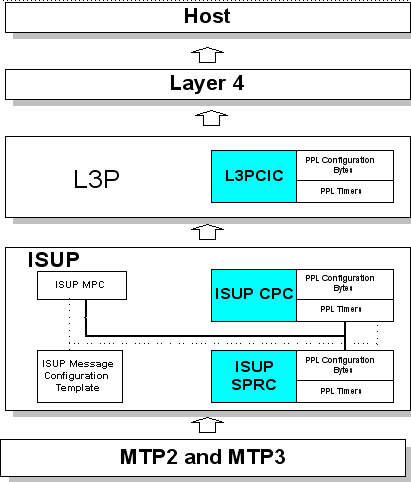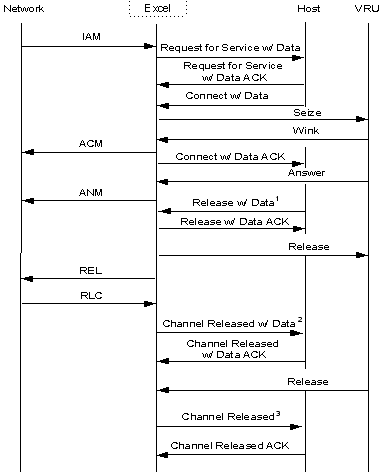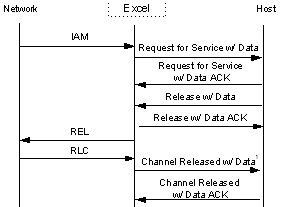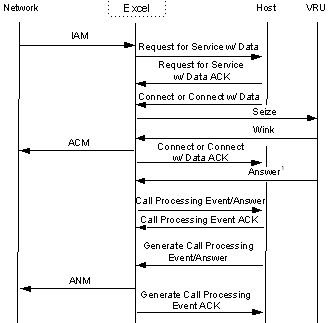
You are here: CSP Developer’s Guide: Common Channel Signaling > 4 SS7 Call Control for ISUP > ISUP Incoming Call Setup

Overview
This section includes call flow examples for ISUP incoming call control.
Diagram of Incoming SS7 Call Handling
The figure below illustrates the default interaction between the host and the SS7 PPL components during an incoming SS7 call. Shading identifies the software components involved in the call.
Figure 4-1 Interaction Between Host and SS7 PPL Component

Sequence of Default Incoming Call
The default incoming call sequence shown in the diagram above is described in the table below.
|
Stage |
Description |
|---|---|
|
1 |
Raw ISUP messages are received by MTP and passed to ISUP. |
|
2 |
ISUP SPRC is responsible for routing the data to the appropriate component. Assuming the data is for a valid CIC, it is routed to ISUP CPC for processing. If the data is maintenance related, it is routed to MPC. In the event of an unrecognized message type or invalid CIC, a CFN or UCIC is sent to the network (for ANSI only). |
|
3 |
Assuming no error conditions occur, ISUP consults the ISUP Message Configuration Template to identify the message and translate the raw data into the format of an SS7 Parameters ICB to pass to L3P. |
|
4 |
L3P passes generic setup indication messages to Layer 4, which drive Layer 4 into an inseized state and generate a Request For Service With Data message to include an SS7 parameters ICB with all received parameters to the host. |
The call flows in this section include more details about the numbered messages. The numbered messages are described following each call flow.
The following call flow uses a Voice Response Unit (VRU) as the outgoing leg of a tandem connection. The VRU is a T1 E&M wink start channel. More details about the numbered messages are provided following the call flow.

1. When using the default L3P, all SS7 parameters in the IAM pass to the host in the Request For Service With Data message in the following format (see Information Control Blocks chapter in the API Reference for information on ICB formats):
• Parameter Name
• Parameter Length
• Parameter Value
You can also configure L3P to send the called and calling party digits as BCD-encoded digit strings by modifying the PPL Configuration Bytes. (See Request for Service message format.)
2. The host must acknowledge the Request For Service With Data message or the CSP resends the message once after 5 seconds.
3. The host must provide mandatory SS7 parameters for the ACM and ANM as determined by the following:
Connect With Data message with SS7 Parameters ICBs (the parameters for each must be sent in separate ICBs). For ANM and ACM, this condition allows the host to dynamically overwrite any pre-stored parameters in the L3P CIC Configuration Bytes.
Connect message using preprogrammed parameter values in the L3P CIC PPL Configuration Bytes.
Generate Call Processing Event of Answer using pre-programmed ACM and ANM parameters.
Propagate answer from VRU using pre-programmed parameters.
4. Because the Voice Response Unit (VRU) is running asynchronously to the CSP, Answer can return anytime after the Wink.
Incoming Call Setup Using CON (Instead of ACM/ANM - for ITU Only)
The following call flow shows a VRU as the outgoing leg of a tandem connection using CON. The VRU is a T1 E&M wink start channel.

1. When using the default L3P, all SS7 parameters included in the IAM pass to the host in the Request For Service With Data message in the following format (see the Information Control Blocks chapter in the API Reference for information on ICB formats):
• Parameter Name
• Parameter Length
• Parameter Value
You can configure the L3P to send the called and calling party digits as BCD-encoded digit strings by modifying the PPL Configuration Bytes (see Request for Service Message format.)
2. The host must ACK the Request For Service With Data message or the CSP will resend the message once after 5 seconds.
3. The host must provide the mandatory SS7 parameters for CON as determined by the following:
• Connect With Data message with SS7 Parameters ICBs (the parameters for each must be sent in separate ICBs).
• Connect message using preprogrammed parameter values in the L3P CIC PPL Configuration Bytes.
• Generate Call Processing Event of Answer using defaults stored in CON parameter.
• Propagate Answer event from the VRU using pre-programmed CON parameters.
4. Because the VRU is running asynchronously to the CSP, Answer returns anytime after the Wink.
5. Connect is set based on the specified setting in L3P CIC Configuration Byte 9.
Incoming Call Setup with Host-initiated Release

1. The host must provide at least the mandatory parameters for the forward REL, either of the following:
• Release With Data message
• Release message using preprogrammed parameter values in the L3P CIC PPL Configuration bytes
2. The Channel Released With Data message contains an SS7 parameter ICB with the parameters from the incoming RLC (Release Complete).
3. A Channel Released message indicates that the VRU channel is idle and ready for a new call.
Incoming Call Rejection by Host

1. The Channel Release With Data message contains an SS7 Parameter ICB with the REL parameters.
Incoming Call with Answer Supervision Mode of "Notify Only"

1. With Answer Supervision set to Notify Only, answer is not propagated to the SS7 channel. A Call Processing Event of Answer is sent to the host for the VRU.
2. To answer an SS7 call, the host may use the Generate Call Processing Event of Answer. The parameters for the ANM will be retrieved from the PPL Configuration Bytes.